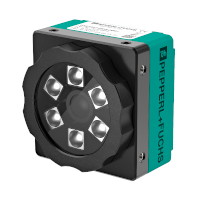Reading Out 1-D, 2-D, and DPM Codes on Vehicle Components with the VOS-I
Reliable Identification for Plant Controllers and ERP Systems

The Application
In the production processes of the automotive industry, components are automatically identified and guided to the next processing step in a targeted way. At the same time, the identification data is used for quality assurance and complete traceability. The parts are usually given a Data Matrix code. Depending on the requirements for robustness, the code is applied to a suitable surface on the component as a label or by laser or needle (direct part marking, DPM). In particular, needle-punched codes on metal place high demands on code reading. Surfaces can be reflective, curved, or dirty; worn needles sometimes produce uneven codes.
The Goal
With very variable and sometimes poor readability, the codes must be reliably read out from a distance of a few centimeters to two meters. The parts may be in motion (< 1 m/s). The reading process must work in the same way for assembly lines as it does for use on robot arms. The data determined is sent to the plant control system and the ERP system in a suitable format, making further adjustments unnecessary. For incorrect readings, a control option is required in the form of comprehensible error images, which can easily be accessed afterward.
The Solution

VOS-I Universal Code Reader
The VOS-I vision sensor has been specially designed to reliably read all standard 1-D and 2-D codes. The lighting of the device can be adapted to the application. The device can use electronic filters to enlarge the code or hide edge effects such as scratches to improve readability. If the code quality decreases in the process, it can be output for DPM codes in accordance with the applicable ISO/IEC TR 29158 standard (AIM DPM). For data communication, all relevant interfaces are available with I/O, Ethernet TCP/IP, PROFINET, EtherNet/IP, and RS-232. The powerful script function can be used to adapt the output string for integration into the ERP system without the effort of having to adapt the system itself.
Technical Features
- Speed of movement up to 4 m/s
- Throughput up to 30 readings/s
- Large distance and sensing ranges (up to 2 m), adjustable focus
- Modular choice of lenses and external lighting options
- Interfaces: TCP/IP, PROFINET, EtherNet/IP, RS-232, and I/O
- Storage of up to 32 jobs on the sensor, match code, multi-code, multi-window, and multi-sensor mode, and output string formatting

The Advantages
The VOS-I vision sensor offers versions with integrated lighting for distances of up to one meter. C-mount versions with a maximum resolution of 5.2 megapixels are available for distances of up to two meters. These versions can be flexibly combined with external lighting and lenses. Side lighting is also possible. This avoids the reflection that can occur with central ambient light of curved surfaces: Even on a round object, the code is reliably read out. With its modular design, the product is not tailored to individual application types, but it is a complete package that can be used flexibly.
At a Glance
- Reliable reading of all 1-D and 2-D codes, including DPM (laser-inscribed/needle-punched)
- Modular camera portfolio consisting of sensor, lighting, and lens with standardized connections
- Integrated evaluation
- Easy system integration and user-defined data output
- Graphical user interface for quick commissioning and sensor parameterization








 +65 6779 9091
+65 6779 9091